The week at a glance
- Sharp-tailed Sandpiper in Somerset
- Buff-bellied Pipit in Waterford
- Blackpoll Warbler in Kent and a possible in Cornwall
- Bufflehead still in Cornwall
- Greater Yellowlegs still in Northumberland
- Wilson's Snipe and Northern Waterthrush still on Scilly
- Brown Shrike again in Argyll
- Veery still in Highland
- Eastern Black Redstarts still in Kent and Northumberland
- Possible Thayer's Gull still in Argyll
November continued to throw up a few surprises, but two county firsts were perhaps not what was on people's minds. Following the lead of the two dowitchers, a juvenile Sharp-tailed Sandpiper that was briefly at Blagdon Lake (Somerset) on 18th duly moved to nearby Chew Valley Lake. Unfortunately this ensured it was never very close, but at least it stayed a while, being present to the end of the week, and was a welcome county first.

Sharp-tailed Sandpiper, Chew Valley Lake, Somerset & Bristol (Photo: Jim Almond)
Sharp-tailed Sandpiper, Chew Valley Lake, Somerset & Bristol (Video: TheMarkhip)
The other county first was equally unexpected: a Blackpoll Warbler in Tunbridge Wells (Kent) on 19th–22nd. This was an excellent garden find for one birder in a small cul-de-sac in the town, but unfortunately it never really played ball for the masses. It showed on and off on 19th but then wasn't seen until 21st, by just two lucky observers. It was then heard calling, and possibly seen, on 22nd, but was never very obliging. There are few east-coast records; the only previous examples are birds on Flamborough Head (East Yorks) in October 1993 and in East Sussex in December 1994 and October 2010.
The only other big new arrival was another Buff-bellied Pipit, this time at Clonea (Waterford) on 22nd–23rd. This follows the bird there last year from October to mid-November.
Many of last week's star birds did remain, though, giving weekend listers the chance to catch up with them. The juvenile Greater Yellowlegs was back at East Chevington (Northumberland) on 17th, before moving on to Druridge Bay and Hauxley later in the day and doing a similar tour of these sites to 20th, when it settled at Cresswell Pond to 22nd before being chased off by a Sparrowhawk. In Cornwall, the female/immature Bufflehead was again at Helston Loe Pool all week . There were two also two intriguing "possibles" reported: an unconfirmed report of a possible female Siberian Thrush at Polgigga on 17th and also an unidentified Dendroica warbler, most likely a Blackpoll, seen briefly in Falmouth on 17th. Neither could be relocated.
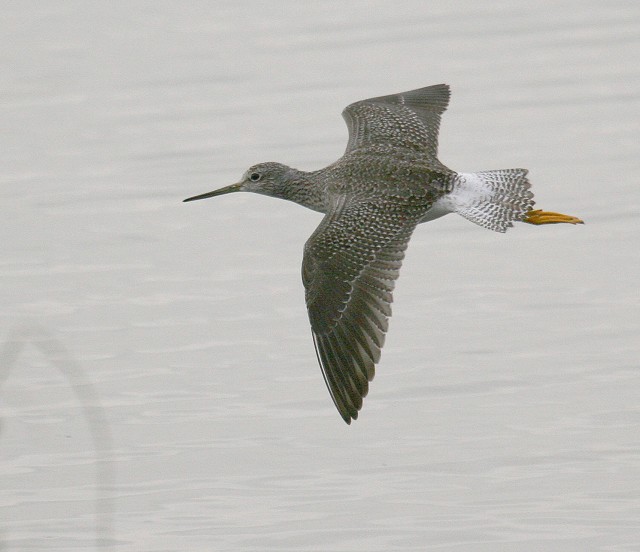
Greater Yellowlegs, Druridge Bay CP, Northumberland (Photo: Lee Johnson)
In Highland, the Veery stayed put in gardens and farmyards on Muck all week, allowing the dedicated to charter boats to see this very attractive thrush. At the opposite end of the country, the Wilson's Snipe remained at Lower Moors (St Mary's, Scilly) all week, and the Northern Waterthrush also put in another appearance on 22nd after an absence of nine days. Interestingly, the first-winter Brown Shrike on Tiree (Argyll) also reappeared, at Carnan Mor on 20th, almost two weeks after it was last seen at Balephuil. Both of last week's photogenic Eastern Black Redstarts remained, at Foreness Point (Kent) to 17th and on Holy Island (Northumberland) to 21st. The possible juvenile Thayer's Gull also remained at Dunbeg (Argyll), reported on 18th and 21st.
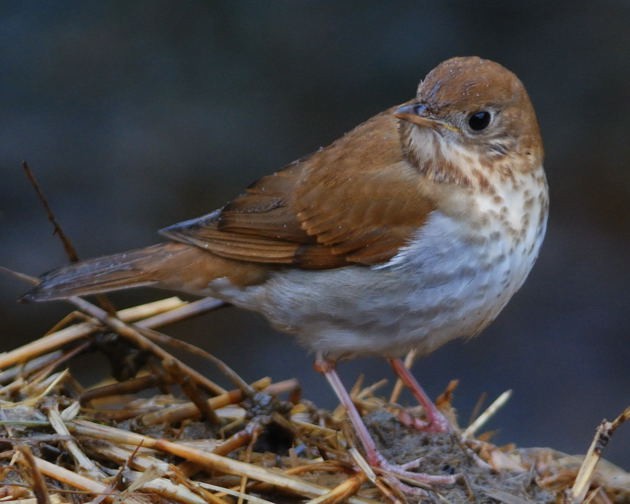
Veery, Muck, Highland (Photo: Dennis Morrison)
Wilson's Snipe, St. Mary's, Isles of Scilly (Video: benjimi1)
Eastern Black Redstart, Holy Island, Northumberland (Video: mistyanddull)
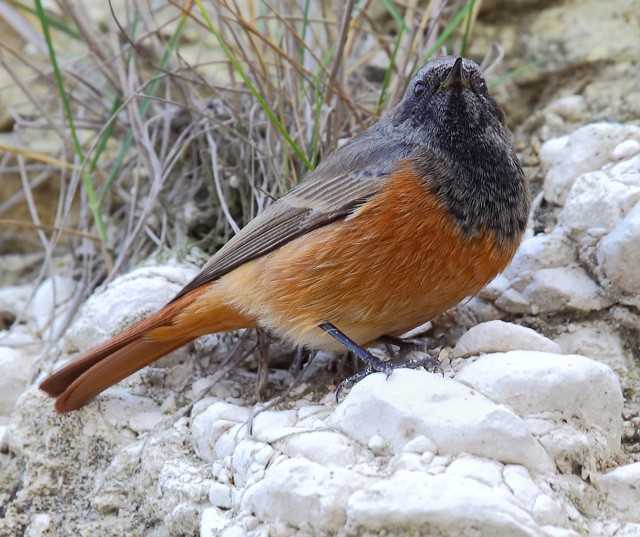
Eastern Black Redstart, Foreness Point, Kent (Photo: Steve Ashton)
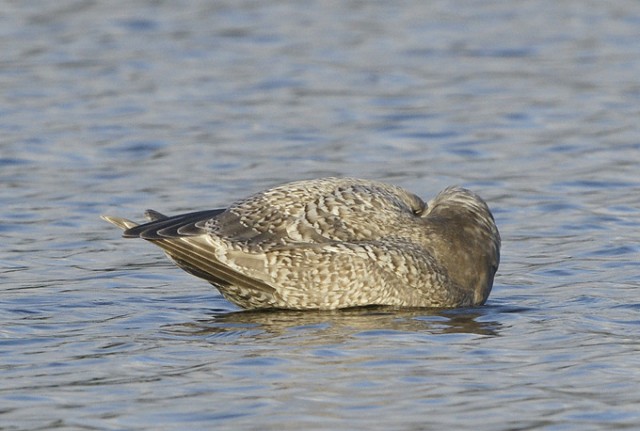
Thayer's or Kumlien's Gull, Dunbeg, Argyll (Photo: Jim Dickson)
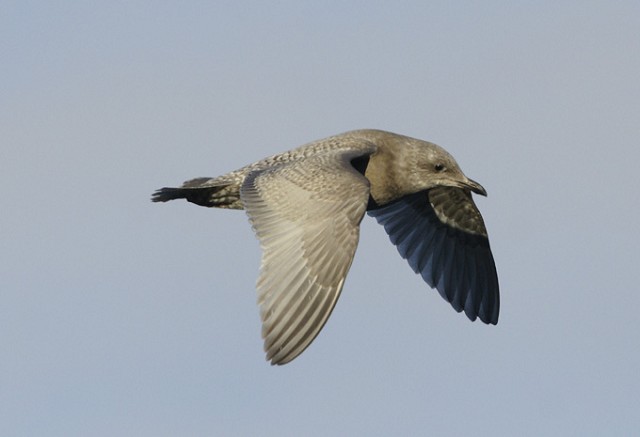
Thayer's or Kumlien's Gull, Dunbeg, Argyll (Photo: Jim Dickson)
Of the more interesting races of Canada Goose, the Richardson's remained at Torr Reservoir (Somerset) to 20th and the Cackling at Newport Wetlands (Gwent) to 19th. A single Ross's Goose was at Snettisham (Norfolk) on 23rd (with an escaped Lesser White-fronted Goose) and the two Northumberland birds were again at Dunstan on 19th–20th (with Pink-feet, 60 Barnacle Geese, 60 White-fronted Geese and two Tundra Bean Geese). The only Snow Goose was a blue-morph bird at Cornaigbeg, Tiree (Argyll) on 17th.
The first-winter Red-breasted Goose remained at Bowling Green Marsh and latterly Topsham to 22nd, and the adult also remained with Dark-bellied Brents and a single Black Brant at West Mersea (Essex) to 21st. A presumed escape also brightened up Walthamstow Reservoirs (London) on 20th. There were surprisingly few other records of Black Brant this week, just birds at Barrow Harbour (Kerry), Butterstreet Cove (Dorset), Warham Greens (Norfolk) and an adult and hybrid family at Carricklahan (Mayo) on 20th. One also remained at Whiteford NNR on the Gower peninsula, just the third record for Wales.
Black Brant, Whiteford NNR, Gower, Glamorgan (Video: TheMarkhip)
The drake American Wigeon turned up again at Rutland Water on 23rd, along with two Smew and 15 Red-crested Pochards. Other American Wigeon also remained at Dawlish Warren (Devon) to 20th and Wintersett Reservoir (West Yorks) to 23rd, and new drakes were at Castle Loch (Dumfries & Galloway) on 17th–22nd and Saleen (Cork) on 19th–20th. In Ireland, the adult female Blue-winged Teal was reported at Bull Island (Dublin) on 21st and a female/immature was at Tacumshin (Wexford) on 21st. There was also a late report of one shot at Upper Lough Erne (Fermanagh) on 10th, identified from a specimen (minus the breast), which was the first for the county. There were still plenty of reports of Green-winged Teal: birds were reported from as many as 13 sites, including new birds in Shetland, Dumfries & Galloway and Northumberland, and two in Cumbria.

Green-winged Teal, Siddick Ponds NR, Cumbria (Photo: Craig Shaw)
There were rather more records of Ring-necked Duck this week. Irish drakes were at Carrowmore Lake (Mayo) and Lough Cowey (Down) on 20th and at Lough Shivnagh (Donegal) on 22nd. In England, drakes were at Gwithian (Cornwall) on 18th and 23rd, Whisby Nature Park (Lincs) on 22nd and Blagdon Lake (Somerset) to 23rd, and two drakes were again at Loch Kinord (Aberdeenshire) on 21st. The long-staying drake Ferruginous Duck remained at Dinton Pastures (Berks) to 19th, while opinion on the drake at Lurgan Park Lake (Armagh) to 19th now seems to favour its being the real deal rather than a hybrid. Another long-stayer was the juvenile Lesser Scaup at Marden Quarry (Northumberland) to 20th. At sea, the female Surf Scoter was again off Ballinskelligs (Kerry) to 20th and a first-winter female was off Hurst Beach (Hants) briefly on 21st, the first in the county for five years.
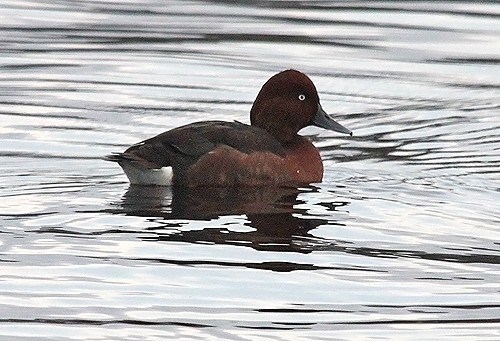
Ferruginous Duck, Lurgan, Armagh (Photo: Derek Charles)
The only Sabine's Gulls were juveniles off Bardsey Island (Gwynedd) on 22nd and past Ainsdale (Lancs) on 23rd. Single Grey Phalaropes were reported past several coastal sites and inland birds remained at Chew Valley Lake (Somerset) and at Queen Elizabeth Reservoir (Surrey) on 23rd.

Grey Phalarope, Hartlepool Headland, Cleveland (Photo: Martyn Sidwell)
In Shetland, the Great White Egrets remained on Whalsay and Out Skerries and others were scattered across 16 sites in England, including two at The Dowels and Dungeness (Kent), while one was at Llandeilo (Carmarthenshire) on 19th and one was at Lough Conn (Mayo) on 18th–19th. Single Cattle Egrets remained at Lydney (Glos) and Blakeney Freshmarsh (Norfolk) all week and there were new arrivals on Tiree (Argyll) on 17th–21st and from Bassenthwaite Lake (Cumbria), belatedly reported on 16th. The only White Stork was one reported from Clifton (Notts) on 23rd. Numbers of Glossy Ibis were slightly down; the species was reported from five sites in England and one in Wales, including new birds at Dungeness (Kent) on 18th–23rd and an unconfirmed report from Bromsgrove (Worcs) on 17th. Others also remained in Dorset, Kent, Essex and on Anglesey.

Great White Egret, Campfield Marsh RSPB, Cumbria (Photo: Sam Northwood)

Glossy Ibis, Malltraeth Marsh RSPB, Anglesey (Photo: Tony Kelso)
The only remaining Pallid Harriers were in County Cork: at Midleton on 19th and Power Head to 21st. Also in Ireland, the second-winter male Northern Harrier was reported at Tacumshin (Wexford) again on 19th. In the Northern Isles, Rough-legged Buzzards were on Whalsay (Shetland) on 18th–21st and Stembister (Orkney) on 17th, while others were at numerous coastal sites between Cleveland and West Sussex, including two in the Wells area of Norfolk. Inland birds were at Ouse Fen (Cambs) all week at Buckstones Moss (West Yorks) on 17th. The autumn run of Gyr Falcons continued with a grey-morph bird in Findhorn Valley (Highland) on 20th, though not since.
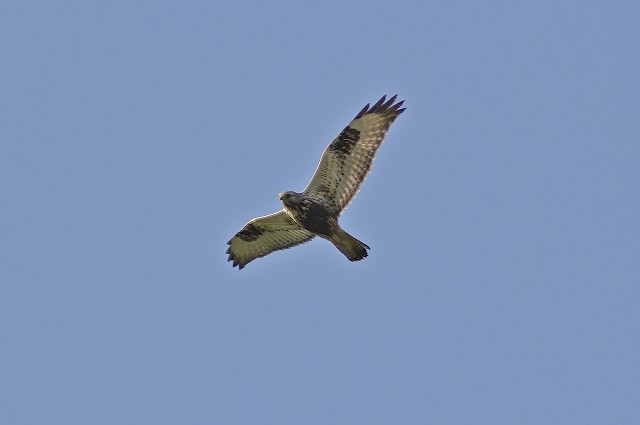
Rough-legged Buzzard, Burpham, West Sussex (Photo: Chris Moore)
The small invasion of Common Cranes continued with new arrivals of three at Ardmore (Waterford) on 20th, two at Belderrig (Mayo) on 21st and a wanderer in Dorset at the end of the week. Up to 33 also remained in Co Cork, while in Cornwall six remained near Lizard village and 27 were at St Mabyn early on 17th, presumably accounting for the 24 seen over Exbourne (Devon) two hours later and Wickham (Hants) five hours later. One of the most bizarre sights of the week must have been the Great Bustard, of obligatory unknown origin, seen in flight over Queen Mother Reservoir (Berks) on 17th; another was in Dorset on 21st.
There was just one American Golden Plover, on the Ythan estuary (Aberdeenshire) again on 20th. Long-stayers included the Lesser Yellowlegs on the Alaw Estuary (Anglesey) to 22nd and Spotted Sandpipers at Chew Valley Lake (Somerset) to 22nd and on the Plym Estuary (Devon) to 23rd. A new juvenile was also at Lyme Regis (Dorset) on 18th–23rd, the first in the county for six years. The two Long-billed Dowitchers continued to commute between Blagdon Lake and Chew Valley Lake (Somerset) all week and one was at Mucking landfill site (Essex) on 19th, though it didn't stay long.

Spotted Sandpiper, Lyme Regis, Dorset (Photo: Barry Jackson)

Long-billed Dowitcher, Mucking landfill site, Essex (Photo: Lea Roberts)
In Cleveland, the wandering Semipalmated Sandpiper was at Saltholme on 22nd–23rd. A juvenile Least Sandpiper at Black Rock Strand (Kerry) on 21st–23rd was apparently different to that at Carrahane Strand in September/October. There is just one previous county record, in August 1965. The only White-rumped Sandpiper was a new bird at West Canvey Marsh (Essex) on 18th and the only Baird's Sandpiper was the long-staying bird on North Ronaldsay (Orkney), which was trapped on 18th: only the third to be ringed in Britain, following other Bird Observatory birds n Fair Isle in 1991 and Bardsey in 2004. The only Pectoral Sandpipers reported were two at Ardmore Point, Lough Neagh (Armagh) on 19th.
With no sign of the Dungeness bird, there were just five Glaucous Gulls reported: at Scatness (Shetland), North Ronaldsay and Waulkmill Bay (Orkney), Loch an Tiumpan (Lewis, Outer Hebrides) and Oban (Argyll). There were also just six Iceland Gulls: at Stromness and Unst (Shetland), Ayr (Ayrshire), Killybegs (Donegal), Belvide Reservoir (Staffs) and Rutland Water. An adult Kumlien's Gull was at Killybegs on 20th. Long-staying Ring-billed Gulls remained at Groomsport (Down), Sandypoint (Dublin), Black Rock Strand (Kerry), Gosport (Hants), Dunbeg (Argyll) and Stornoway (Lewis, Outer Hebrides), while two new birds were in County Cork on 19th, at Kilbrittain and a first-winter at Bantry. The probable adult Azorean Yellow-legged Gull was in the roost again at Chasewater (Staffs) on 17th–18th and a possible first-winter Baltic Gull was in fields at Bempton Cliffs (East Yorks) on 17th–18th. In County Galway, the wintering Forster's Tern was at Kinvarra on 19th.
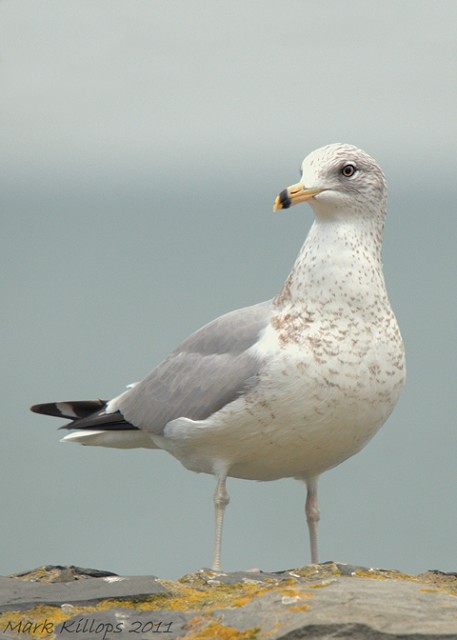
Ring-billed Gull, Groomsport, Down (Photo: Mark Killops)
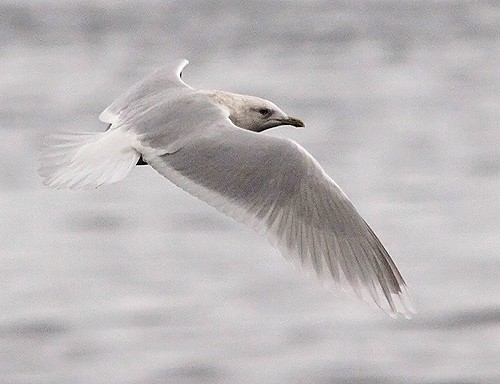
Kumlien's Gull, Killybegs, Donegal (Photo: Derek Charles)

Possible Baltic Gull, Bempton Cliffs RSPB, East Yorkshire (Photo: Andy Hood)
The only Hoopoe was one reported from Greatstone-on-Sea (Kent) on 18th and there was also a late Red-rumped Swallow at Winterton-on-Sea (Norfolk) on 18th. There were no reports of Shore Lark from Norfolk this week; singletons were at West Voe of Sumburgh (Shetland), Swalecliffe (Kent) and Mudeford (Dorset) on 22nd (the last also at Stanpit Marsh on 23rd), and there were twos at Sandwich Bay (Kent) to 18th and Walton-on-the-Naze (Essex) to 19th.
Richard's Pipits were reported from just four sites this week: brief birds were at Goonhilly Downs (Cornwall) and Marloes Mere (Pembrokeshire) on 19th and more obliging birds were at Hornsea Mere (East Yorks) on 18th–21st and remaining at Leasowe (Cheshire) to 18th. The only remaining Olive-backed Pipit was again at Norwick, Unst, to 19th.
There seemed to be a further arrival of Great Grey Shrikes, with much larger numbers across Scotland, northern England and at four sites in Wales. Most notable were three in Pantmaenog Forest (Pembrokeshire) on 19th. The week's only Bluethroat was at Clonea (Waterford) on 20th–23rd. Following the male there earlier in the autumn, a female Desert Wheatear was at Porthgwarra (Cornwall) on 21st–22nd. There was a photogenic male at Man Sands (Devon) on 18th–22nd and another new male on Bull Island (Dublin) on 20th–21st. This was the second record for the county, following one at Skerries on 19th!

Desert Wheatear, Man Sands, Devon (Photo: John Lee)
There were still reasonable numbers of Waxwings in Scotland and along the east coast of England, peaking at 40 in Lowestoft (Suffolk), 28 in St Andrews (Fife), 28 in Cramlington (Northumberland), 26 in Holt (Norfolk), 25 in Ashington (Northumberland) and 20 in Aberdeen. Inland birds included five over Hatfield Moors (South Yorks) on 17th, four at Heeley, Sheffield (South Yorks) on 20th and six at Cheltenham (Glos) on 19th.

Waxwing, Holt, Norfolk (Photo: Steve Houghton)
In what is turning out to be a record year for Dusky Warblers, there was a small arrival in the southwest this week. In Cornwall, birds were at Kennack Sands on 20th, Cadgwith on 21st–22nd and Housel Bay on 21st–22nd, while on Scilly there were three on St Mary's on 19th, including one ringed at Porth Hellick. Elsewhere, birds remained at Horsey (Norfolk) to 17th and Spurn (East Yorks) to 18th. There were just five Pallas's Warblers this week, including new birds at Knockadoon Head (Cork) on 20th–21st, Dungeness (Kent) on 20th–23rd, Winterton Dunes (Norfolk) on 17th and a possible at Dingle Marshes (Suffolk) on 20th. One also remained at Power Head (Cork) to 19th. There were also fewer Yellow-browed Warblers, with reports from just seven sites in East Yorkshire, Norfolk, Kent, West Sussex and Cornwall and various birds on St Mary's and St Agnes (Scilly). There were actually far more Hume's Leaf Warblers: reports came from 11 sites this week. In Shetland alone, birds were at Grutness, Gulberwick, Trondra and Whalsay, and further birds were at Loch of Swannay (Orkney), Foveran Links (Aberdeenshire), Holme NOA and Great Yarmouth (Norfolk), Lowestoft (Suffolk) and Wyke Regis (Dorset). There was also a probable at Knockadoon Head (Cork) on 19th, which would be the second for the county following one at the same site in winter 2003/04.

Dusky Warbler, St. Mary's, Isles of Scilly (Photo: Joe Pender)
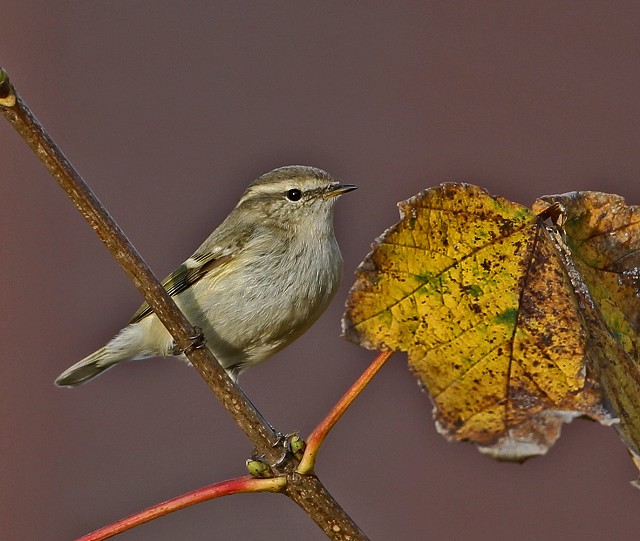
Hume's Leaf Warbler, Lowestoft, Suffolk (Photo: Ian Clarke)
The Red-breasted Flycatcher remained on St Mary's (Scilly) all week. There were two Penduline Tits at Grove Ferry (Kent) on 20th with at least one still present on 22nd. One was also ringed at Leighton Moss (Lancs) on 21st. Also finding a ringer's net was a Little Bunting at Steyning (West Sussex) on 19th and another went over Durlston Country Park (Dorset) on the same date. Lapland Bunting weren't as widespread as in recent weeks and numbers were certainly down. The peak counts were of just eight at Donna Nook (Lincs) and seven at Spurn (East Yorks), the rest being singletons and twos. The only inland bird was at Creekmouth (London) on 17th.

Red-breasted Flycatcher, St. Mary's, Isles of Scilly (Photo: Martin Goodey)
Last week's juvenile Rose-coloured Starling remained at Lodmoor (Dorset) all week and one also roosted with Starlings again at Slapton Ley on 23rd. Two more birds also reappeared after long absences: at St Columb Minor (Cornwall) on 17th (last reported on 31st October) and Holyhead (Anglesey) on 20th–23rd (last reported on 10th October). There was just one new bird, in a garden at West Bergholt (Essex) on 22nd.

Rose-coloured Starling, Holyhead, Anglesey (Photo: Philip Coombs)
Photo of the Week: 17th–23rd November
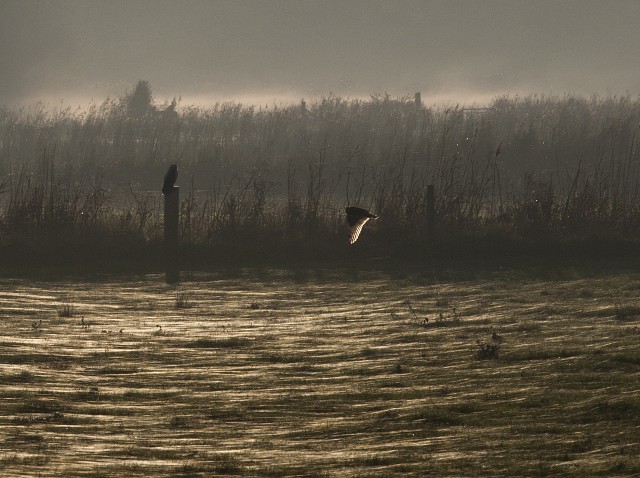
Short-eared Owl, Kessingland, Suffolk (Photo: Chris Darby)
Over the last couple of weeks, we've had some excellent photos of Short-eared Owls from a variety of locations around the UK. These have included some stunning close-range images of both perched and flying birds, in some cases too close to fit in the frame! Standing out from this collection, though, is an image by Chris Darby featuring two SEOs that are very small in the frame. Chris's uploads have included a wide range of scarcer birds from East Anglia and, like most other bird photographers, he normally strives to get close enough to capture good detail in his subjects. His first Photo of the Week, though, shows what can be achieved by choosing a shorter focal length lens (and a small aperture) to show birds in their surroundings, especially when there's something special about those surroundings. In this case, Chris picked out two of the six owls present at the site, one hunting over a field while the other looked on from a fence post. By shooting towards the sun, Chris caught the flying bird with its wings lit up by transmitted sunlight. Even better, though, a blanket of cobwebs covering the foreground field and a bank of mist in the distance were both perfectly backlit to create a wonderfully atmospheric composition.
Other notable photos
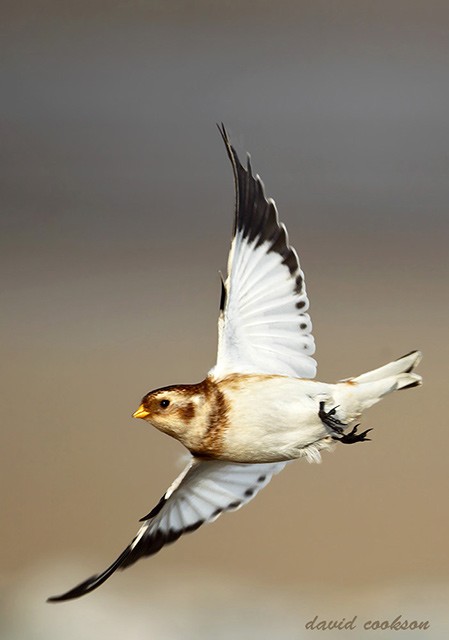
Snow Bunting, Kinmel Bay, Conwy (Photo: David Cookson)

Waxwing, Holt, Norfolk (Photo: Graham Munton)
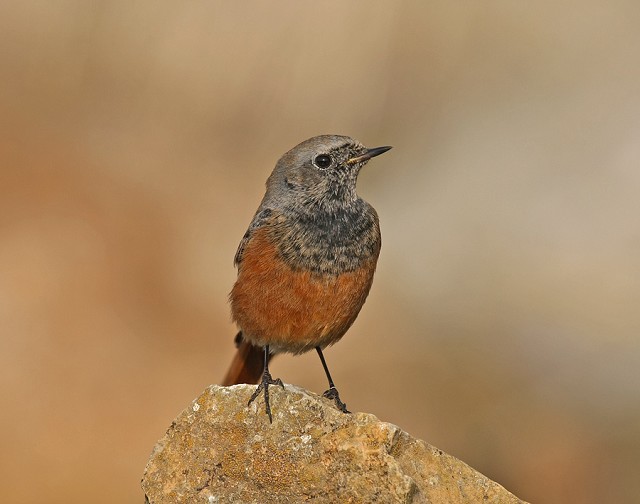
Eastern Black Redstart, Holy Island, Northumberland (Photo: Dave Hutton)
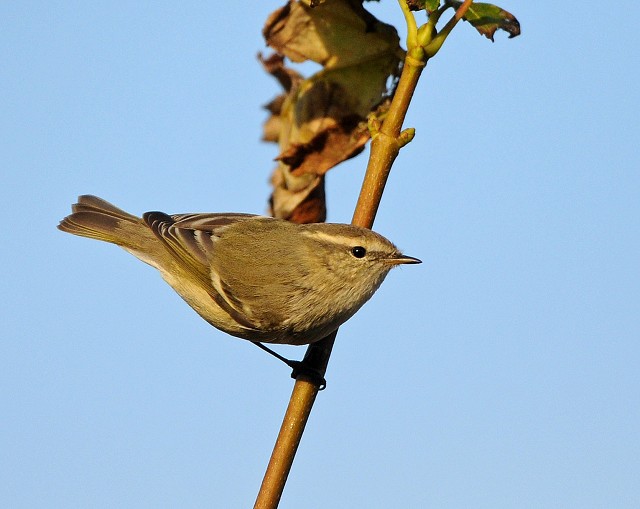
Hume's Leaf Warbler, Lowestoft, Suffolk (Photo: Jon Evans)

Turkestan Shrike, Qatar (Photo: John A Thompson)

Common Kestrel, Worlaby Carrs, Lincolnshire (Photo: Andy Shepherd)

Red-throated Diver, Cresswell Pond NWT, Northumberland (Photo: Morgan)

Bearded Tit, undisclosed site, Essex (Photo: Pixellence)

Sparrowhawk with Snipe, London Wetland Centre WWT, Greater London (Photo: Tom Hines)

Dartford Warbler, undisclosed site, Suffolk (Photo: Matty Fidler)

Purple Sandpiper, North Wirral, Cheshire (Photo: Steve Round)

Moorhen, Slimbridge WWT, Gloucestershire (Photo: Gerhard)

Meadow Pipit, Kinmel Bay, Conwy (Photo: Tom Melton)

Tree Sparrow, Dungeness RSPB, Kent (Photo: Will Rawles)

